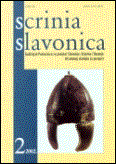OSNIVANJE I DJELATNOST ČETNIČKIH UDRUŽENJA NA PODRUČJU SLAVONSKOBRODSKOG KOTARA U RAZDOBLJU KRALJEVINE JUGOSLAVIJE
THE FOUNDATION AND ACTIVITIES OF CHETNIK ASSOCIATIONS IN THE SLAVONSKI BROD DISTRICT IN THE PERIOD OF THE KINGDOM OF YUGOSLAVIA
Author(s): Zdravko DizdarSubject(s): History
Published by: Hrvatski institut za povijest
Summary/Abstract: In the period of the Kingdom of Yugoslavia, in the area of Slavonski Brod, the Chetniks had a particular aim because of its ethnic composition (90% of the population being ethnically Croat) and geographical position (as a crossroads, and as standing between the Serbs in Bosnia and those on Krndija and Papuk mountains, and on the Pozeska Hills and Psunj, and between those in the east and those in the west of Slavonia). This was to help the Greater Serbian-inclined authorities to suppress the Croatian national movement gathered primarily around the HSS and to work on the Serbianisation of the area; like the rest of Slavonia, they considered it an integral part of the Greater Serbia that they had imagined. From the very beginning they had the support of the ruling Greater Serbian circles (the Radical and Democratic parties), which were also the founders of the first Chetnik associations. In Slavonski Brod, the first to be founded was a sub-committee of the Petar Mrkonjiæ Association of Chetniks for King and Fatherland, dissolved at the end of 1929. During the January 6 dictatorship, Chetnik associations went on working within the framework of the Association of Chetniks for the Freedom and Honour of the Fatherland, headed by voyvoda Kosta Peæanac – this one failing to include the “tribal” (Serbian) name in its title. The numbers of organisations and members was constantly on the rise, particularly after the assassination of King Aleksandar in 1934. During 1934 and up to autumn 1935, subcommittees of Chetnik organisations were founded in Bebrina, Brodski Zdenci, Klokoèevik, Kujnik, Novo Topolje, Sibinj, Slavonski Kobaš, Stari Slatnik and Slavonski Brod. There were soon serious clashes between the government and certain Chetnik members with the Croatian peasants; these ended with the bloodshed in Sibinj (19 February 1935) and by the cemetery in Slavonski Brod (20 February 1935), with a total of 15 peasants killed. The governmental reign of terror and support for Chetniks continued in the next few months, but it had an opposite reaction, leading to the Croatian population rallying around the HSS, which had great success in the election in May 1935. In these changed political circumstances after 1935, constant incidents became undesirable, which led to an official ban on the public work of Chetnik associations in the Slavonski Brod district (30 October 1935). The Chetnik subcommittee in the city was not officially prohibited, but in these new political circumstances it stopped working of its own accord. Some of the members of the earlier Chetnik associations went on working in other organisations with similar plans. Although these associations were not renewed until the beginning of the war in 1941, the consequences of their work remained, ever-present among the Croatian population of the area.
Journal: Scrinia Slavonica
- Issue Year: 2002
- Issue No: 2
- Page Range: 75-116
- Page Count: 42
- Language: Croatian

